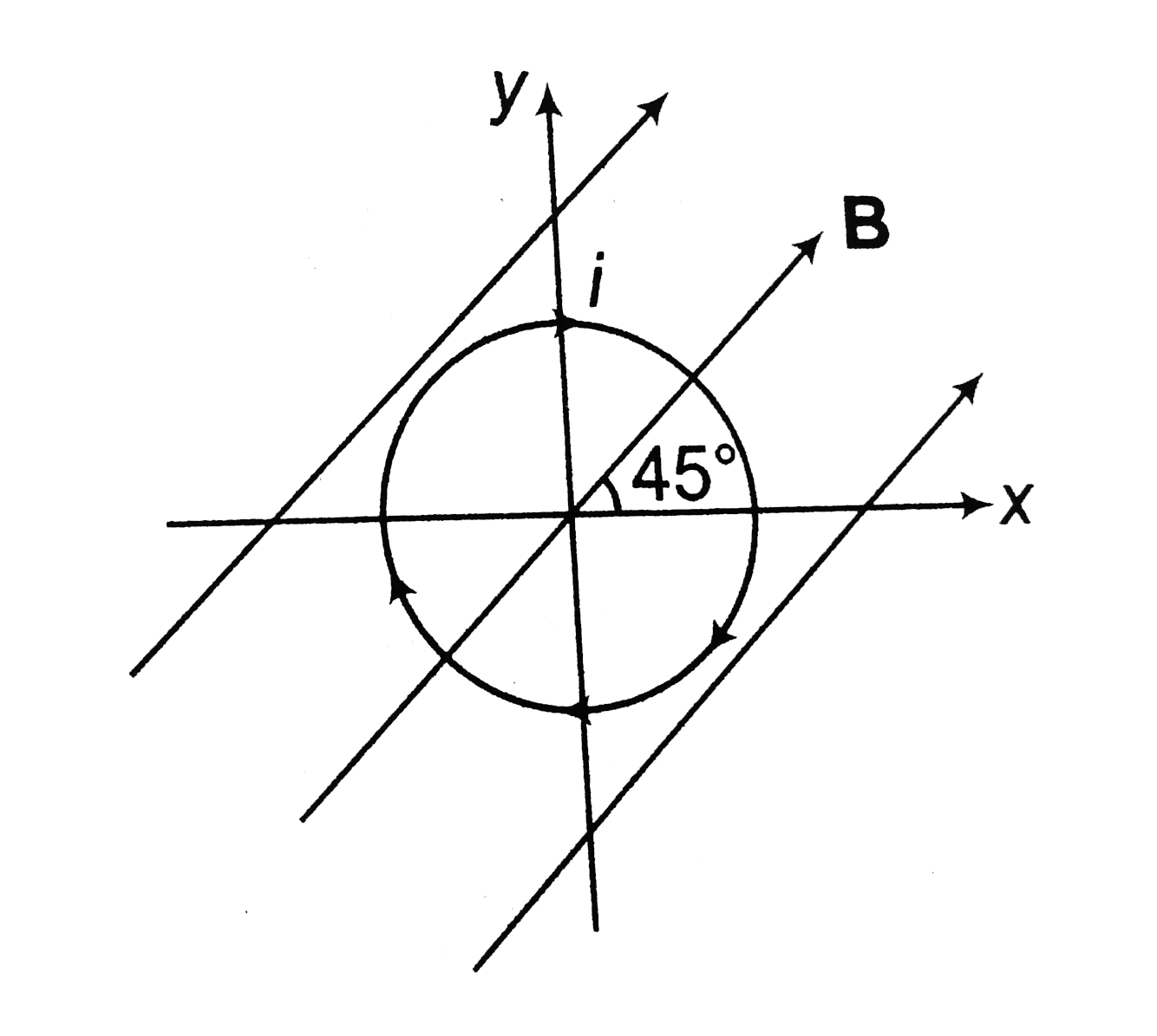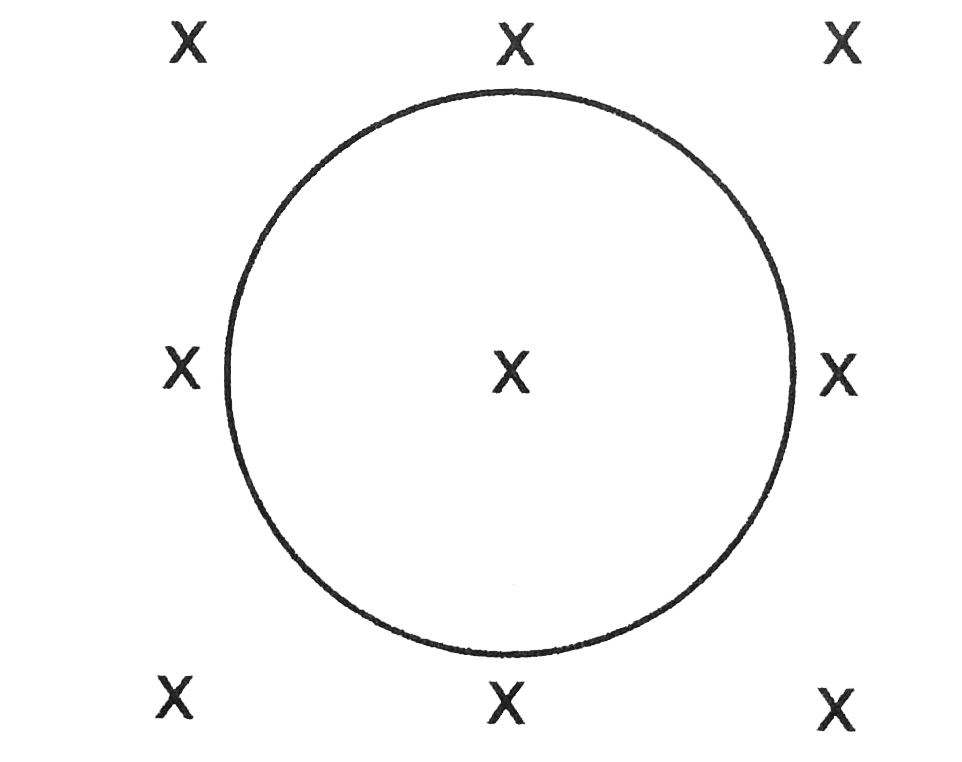A stationary circular loop of radius a is located in a magnetic field which varies with time from t=0→t=T according to law B=B0t(T−t). If plane of loop is normal to the direction of field and resistance of the loop is R, calculate
amount of heat generated in the loop during this interval.
π2a4B20T33R
π2a4B20T3R
3π2a4B20T3R
None of these
The correct Answer is:A
To solve the problem of calculating the amount of heat generated in a stationary circular loop of radius a located in a time-varying magnetic field, we will follow these steps:
Step 1: Determine the Magnetic Field
The magnetic field is given by the equation:
B(t)=B0t(T−t)
where B0 is a constant, T is the total time, and t is the time variable.
Step 2: Calculate the Magnetic Flux
The magnetic flux Φ through the loop is given by:
Φ=B⋅A
where A is the area of the loop. For a circular loop of radius a, the area A is:
A=πa2
Thus, the magnetic flux becomes:
Φ(t)=B(t)⋅A=B0t(T−t)⋅πa2=B0πa2t(T−t)
Step 3: Calculate the Induced EMF
According to Faraday's law of electromagnetic induction, the induced electromotive force (emf) ϵ is given by:
ϵ=−dΦdt
Calculating the derivative of the magnetic flux:
dΦdt=B0πa2(T−2t)
Thus, the induced emf is:
ϵ=−B0πa2(T−2t)
Step 4: Calculate the Induced Current
Using Ohm's law, the induced current I in the loop can be expressed as:
I=ϵR=−B0πa2(T−2t)R
Step 5: Calculate the Power Dissipated
The power P dissipated in the loop is given by:
P=I2R
Substituting for I:
P=(−B0πa2(T−2t)R)2R=B20π2a4(T−2t)2R
Step 6: Calculate the Total Heat Generated
The total heat Q generated in the loop over the time interval from 0 to T is given by:
Q=∫T0Pdt=∫T0B20π2a4(T−2t)2Rdt
Factoring out the constants:
Q=B20π2a4R∫T0(T−2t)2dt
Step 7: Evaluate the Integral
Now we need to evaluate the integral:
∫T0(T−2t)2dt
Expanding the integrand:
(T−2t)2=T2−4Tt+4t2
Thus:
∫T0(T−2t)2dt=∫T0T2dt−4T∫T0tdt+4∫T0t2dt
Calculating each integral:
1. ∫T0T2dt=T2⋅T=T3
2. ∫T0tdt=T22
3. ∫T0t2dt=T33
Putting it all together:
∫T0(T−2t)2dt=T3−4T⋅T22+4⋅T33=T3−2T3+4T33=T33
Step 8: Substitute Back to Find Q
Now substituting back into the equation for Q:
Q=B20π2a4R⋅T33=B20π2a4T33R
Final Answer
Thus, the amount of heat generated in the loop during the interval from t=0 to t=T is:
Q=B20π2a4T33R
The magnetic field is given by the equation:
B(t)=B0t(T−t)
where B0 is a constant, T is the total time, and t is the time variable.
The magnetic flux Φ through the loop is given by:
Φ=B⋅A
where A is the area of the loop. For a circular loop of radius a, the area A is:
A=πa2
Thus, the magnetic flux becomes:
Φ(t)=B(t)⋅A=B0t(T−t)⋅πa2=B0πa2t(T−t)
According to Faraday's law of electromagnetic induction, the induced electromotive force (emf) ϵ is given by:
ϵ=−dΦdt
Calculating the derivative of the magnetic flux:
dΦdt=B0πa2(T−2t)
Thus, the induced emf is:
ϵ=−B0πa2(T−2t)
Using Ohm's law, the induced current I in the loop can be expressed as:
I=ϵR=−B0πa2(T−2t)R
The power P dissipated in the loop is given by:
P=I2R
Substituting for I:
P=(−B0πa2(T−2t)R)2R=B20π2a4(T−2t)2R
The total heat Q generated in the loop over the time interval from 0 to T is given by:
Q=∫T0Pdt=∫T0B20π2a4(T−2t)2Rdt
Factoring out the constants:
Q=B20π2a4R∫T0(T−2t)2dt
Now we need to evaluate the integral:
∫T0(T−2t)2dt
Expanding the integrand:
(T−2t)2=T2−4Tt+4t2
Thus:
∫T0(T−2t)2dt=∫T0T2dt−4T∫T0tdt+4∫T0t2dt
Calculating each integral:
1. ∫T0T2dt=T2⋅T=T3
2. ∫T0tdt=T22
3. ∫T0t2dt=T33
∫T0(T−2t)2dt=T3−4T⋅T22+4⋅T33=T3−2T3+4T33=T33
Now substituting back into the equation for Q:
Q=B20π2a4R⋅T33=B20π2a4T33R
Thus, the amount of heat generated in the loop during the interval from t=0 to t=T is:
Q=B20π2a4T33R
Topper's Solved these Questions
- BOOK - CENGAGE PHYSICS ENGLISHCHAPTER - MISCELLANEOUS VOLUME 5EXERCISE - Integer12videos
MISCELLANEOUS VOLUME 5
- BOOK - CENGAGE PHYSICS ENGLISHCHAPTER - MISCELLANEOUS VOLUME 5EXERCISE - Multiple Correct34videos
MISCELLANEOUS VOLUME 5
- BOOK - CENGAGE PHYSICS ENGLISHCHAPTER - MISCELLANEOUS VOLUME 3EXERCISE - True and False3videos
MISCELLANEOUS VOLUME 3
- BOOK - CENGAGE PHYSICS ENGLISHCHAPTER - NUCLEAR PHYSICSEXERCISE - ddp.5.514videos
NUCLEAR PHYSICS
Similar Questions
A stationary circular loop of radius a is located in a magnetic field which varies with time from t = 0 to t = T according to law B=B0t(T−t). If plane of loop is normal to the direction of field and resistance of the loop is R, calculate
magnitude of charge flown through the loop from instant t = 0 to the instant when current reverses its direction.View SolutionA conducting metal circular-wire-loop of radius r is placed perpendicular to a magnetic field which varies with time as B=B0e−t/τ, where B0andτ are constants, at time = 0. If the resistance of the loop is R then the heat generated in the loop after a long time (t→∞) is :
View Solution
Knowledge Check
- Question 1 - Select One
A conducting metal circular-wire-loop of radius r is placed perpendicular to a magnetic field which varies with time as B=B0e−t/τ, where B0andτ are constants, at time = 0. If the resistance of the loop is R then the heat generated in the loop after a long time (t→∞) is :
Aπ2r4B402τRBπ2r4B202τRCπ2r4B20RτDπ2r4B20τR - Question 2 - Select One
A conducting circular loop of radius r carries a constant current i. It is placed in a uniform magnetic field B such that B is perpendicular to the plane of loop. What is the magnetic force acting on the loop?
AI r BB2πrIBCzeroDπrIB
A circular loop of radius R=20 cm is placed in a uniform magnetic field B=2T in xy-plane as shown in figure. The loop carries a current i=1.0A in the direction shown in figure. Find the magnitude of torque acting on the loop.
 View Solution
View SolutionA circular loop of radius R=20 cm is placed in a uniform magnetic field B=2T in xy-plane as shown in figure. The loop carries a current i=1.0A in the direction shown in figure. Find the magnitude of torque acting on the loop.
 View Solution
View SolutionA magnetic flux through a stationary loop with a resistance R varies during the time interval τ as ϕ=at(τ−t). Find the amount of heat the generated in the loop during that time
View SolutionA circular loop is placed in magnetic field B=2t. Find the direction of induced current produced in the loop.
 View Solution
View SolutionA circular wire loop of radius r is placed in a region of uniform magnetic field B such that the plane of the loop makes an angle θ with the direction of B. In which of the following conditions, will no emf be induced in the loop?
View SolutionA triangular loop of side l carries a current I. It is placed in a magnetic field B such that the plane of the loop is in the direction of B. The torque on the loop is
View Solution
